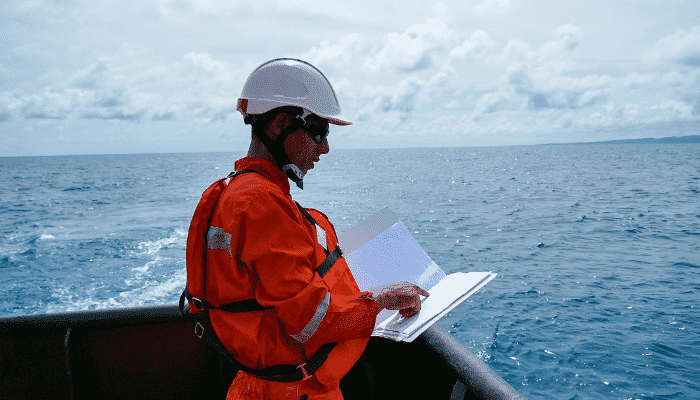International Safety Management Code (ISM)
Course Description:
The International Safety Management (ISM) Code is an international standard to ensure safety, prevent injury, and avoid damage to the environment. ISM requires companies to establish Safety Management Systems (SMS) and provide necessary resources to implement key safety management objectives.
Topics:
- Identify key ISM objectives
- Learn and define the responsibilities of the Company, Master, Safety Officer and Crew
- Understand important Certificates of Compliance, including the Document of Compliance and Safety Management Certificate
- Review the 7 required components of a Safety Management System (SMS
Why Choose this Training Course?
The International Maritime Organization (IMO), introduced the ISM Code to the industry in 1998, it is now mandatory for a wider range of cargo ships and for mobile offshore drilling units (MODU’s), and it is seen as a major instrument to safeguard seafarers from workplace hazards. Past maritime major incidents were a terrible warning bell that highlighted the importance of a Safety management System on board Vessels and Offshore Installations. By attending this intensive 5 Day training, the participants will develop a key understanding of the mandatory ISM Code, the very regulation which is impossible to ignore in today’s highly regulated industry.
This PetroKnowledge training course will highlight:
The reasons and background of the implementation of the ISM Code
The governing principles of the ISM Code
The Companies responsibilities
The Role of the Designated Person Ashore (DPA)
ISM compliance, internal audits and the system of external verification
Safety Management Systems – Hazard identification and Risk assessments methodologies -and their role in the ISM Code
What are the Goals?
The main objective is to ensure that the ISM Code is well understood in its principle, which envisages a self-regulated Safety Management System developed by the Company. This objective can be fulfilled only with a participatory approach, and this topical element of the Code will be thoroughly discussed.
By the end of this training course, participants will be able to:
- Understand and explain the context of maritime safety in general and of the ISM in particular
- Understand the impact of this globally applicable legislation in the maritime industry
- Comprehend the effectiveness of the ISM Code and its latest revisions
- Understand the accountability that the ISM Code has placed on the Companies
- Understand the three central elements: risk assessment, incident reporting and audit and review
Organizational impact:
Shipping Companies must comply with ISM Code, by sending employees to attend this training Course the Management will:
Ensure Compliance
Enable the Company to obtain the Document of Compliance
Enable Vessels to obtain the Safety Management Certificate
Ensure that the Roles and Responsibilities are well understood
Highlight the Roles of the DPA and Masters
Avoid Non-Conformities to the Code
Personal impact:
The participants will gain new knowledge and will have the opportunity to interact with industry experts and colleagues who are most likely facing the same work challenges. In brief, the benefits for the participants can be summarized as follows:
- New skills and knowledge can be acquired
- Existing skills and knowledge can be enhanced or updated.
- Improvements in confidence, job satisfaction, capability and competence
- Learning is progressed to practice in the workplace
- Increased capacity to adopt new ideas and methods
- Learning is used to improve performance at work
- Learning is shared, enhancing team performance
Day One: The Background to the International Safety Management Code
- Introduction – Course Objective
- Historical context of maritime safety
- Where did the ISM Code come from
- The ISM Code within maritime legislation – Safety of Life at Sea (SOLAS)
- Regulatory bodies
- Legal and insurance issues
Day Two: The Aims, Structure and Content of the ISM Code
- The ISM Code in full
- Preamble
- Part A – Implementation
- Part B – Certification and Verification
- Certificates – Document of Compliance (DOC) & Safety Management Certificate (SMC)
- The road from starting to full term certification
Day Three: Company Responsibilities, Authority and Obligations
- Company responsibilities
- The Safety Management System (SMS)
- The Role of the Designated Person Ashore (DPA)
- Responsibility, authority, accountability of the DPA
- Master’s responsibility and authority
Day Four: Operational Safety Management – Shipboard Operations
- Functional requirements of an SMS
- Basis of an effective Management System
- Key component and role of an SMS
- Reports and analysis of non-conformities, accidents and hazardous occurrences
- Emergency preparedness
- Drills and Exercises
Day Five: Risk Assessment and Management
- Incident investigation, event and causal factor
- Hazard identification techniques
- Risk assessment – qualitative and quantitative methods
- Risk reduction
- Safety Culture
- Internal audits and effective communication
Course Overview:
Aims & Objectives
- Identify the key requirements and benefits of the ISM Code
- Provide the knowledge and skills required in accordance with the guidance and recommendation given by the IMO MSC-MEPC.7/circ.6
- Deliver the training necessary for the application and maintenance of a company’s Safety Management Code.
Learning Outcomes
Having successfully completed this course you will be able to:
- have an extended knowledge and understanding of the ISM Code
- understand the background and objectives of the Code
- gain knowledge of the applicable codes, guidelines and standards as appropriate and the relevant mandatory rules and regulations
- define the resulting requirements for the company’s SMS
- understand the responsibilities and authority of the DPA, possible legal exposure, as well as other potential difficulties
- take the duties of a DPA as defined in IMO MSC – MEPC.7 Circ 6 provided you are qualified according to this circular
- provide documentary evidence as a DPA proving that you are capable to undertake the necessary duties.
- understand the assessment techniques of examining, questioning, evaluating and reporting
- have guidance for participation in a marine-related management system audit
- have adequate knowledge of shipping and shipboard operations
- apply the technical and operational aspects of their Safety Management System.
- carry out effective communications with shipboard staff and senior management
- know the related requirements included STCW 2010 and MLC 2006 for better understanding of ISM effect
Who should attend?
- Shipping Companies
- Personnel involved in Safety Management Systems
- Superintendents
- Quality Managers
- DPAs
- Assistant DPAs
- Deck & Engine officers
- Anyone who seeks a DPA position
Course Outlines:
- INTRODUCTION
- Definitions
- Objectives
- Application
- Functional Requirements for a Safety Management System (SMS)
- SAFETY AND ENVIRONMENTAL PROTECTION POLICY
- Policy and Management relation
- COMPANY RESPONSIBILITIES AND AUTHORITY
- What Responsibility / What is Authority?
- How the Company should comply with the Code
Part B Contents: Chapters 4-7
- DESIGNATED PERSON(S)
- Who is DPA ?
- What DPA verifies and monitors
- What the Company should provide to DPA
- DPA Qualifications
- DPA Training
- DPA Experience
- MASTER’S RESPONSIBILITY AND AUTHORITY
- Master and SMS
- RESOURCES AND PERSONNEL
- Qualifications, Training & Experience for Crew and Persons Ashore
- Working Language in SMS
- ISM Chapter 6 & STCW
- STCW Compliance
- New STCW requirement for Engine Room
- New STCW requirement for Bridge
- What is “Company” for STCW?
- SHIPBOARD OPERATIONS
- Plans & Procedures Preparation
Part C Contents: Chapters 8-9
- EMERGENCY PREPAREDNESS
- Comments for Emergencies
- Comments on Near misses
- Hazardous Situations
- Near miss Pros & Cons
- Near miss and Companies
- Defining near miss
- General examples of a near-miss
- Barriers to reporting near-misses
- Barriers and management initiatives
- Near miss investigation process
- Identifying causal factors
- Completing the investigation – Final Report Basic Elements
- REPORTS AND ANALYSIS OF NON-CONFORMITIES, ACCIDENTS AND HAZARDOUS OCCURRENCES
- Reporting & Analysing of NCs, Observations, Accidents and Hazardous Occurrences
- Result of Evaluation Report
- Major Non Conformities (MNC)
- MNC and DoC
- MNC and SMC
- Assessments of Risks and Non Conformities
- The Power of the Non-Conformity
- Risk Categories
- Risk management: Risk Control Measures
- How/What to Report in a NC report
- What to Include in a Conformity Report
Part D Contents: Chapters 10-14
- MAINTENANCE OF THE SHIP AND EQUIPMENT
- Maintenance planning – Areas to be included
- Maintenance planning – Examples
- Maintenance planning – Key Issues
- Maintenance planning & reports
- Maintenance planning & Critical Equipment
- DOCUMENTATION
- Records & Verification
- What Company should provided
- COMPANY VERIFICATION, REVIEW AND EVALUATION
- Review of Safety Management System (SMS)
- Internal Audits Intervals Key Issues
- Internal Audit ? at which extent?
- Internal Audit Why ?
- Internal audit before an external audit
- What about DPA and Audits?
- CERTIFICATION AND VERIFICATION
- Requirements for SMC
- Requirements for DoC
- INTERIM
- Interim DoC
- Interm SMC
Part E Contents: Chapters 15-16
- VERIFICATION
- Audit report
- Corrective action follow-up
- More Company responsibilities pertaining to safety management audits
- Responsibilities of the Organization (or Flag) performing the ISM Code certification
- Standards of Management for the Organization performing Certification
- Qualification Arrangements
- Certification Procedures & Instructions
- Responsibilities of the verification team & Lead Auditor
- More Guidance for Certification / Verifications
- Standards for Auditors
- Standards of Competence for Auditors
- FORMS OF CERTIFICATES
- Document of Compliance
- Safety Management Certificate
- Interim Document of Compliance
- Interim Safety Management Certificate

Entry Requirements:
Passport, Seaman, COC
Duration:
3 Days
